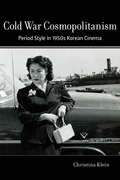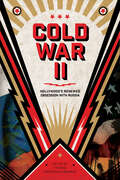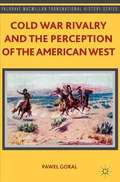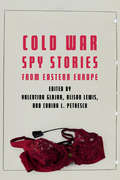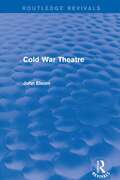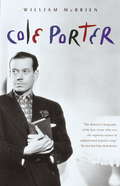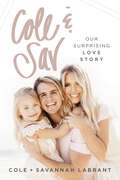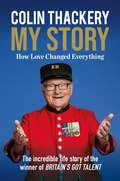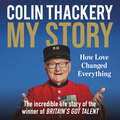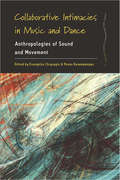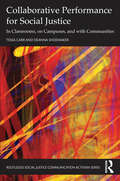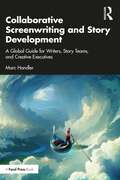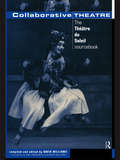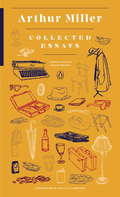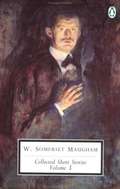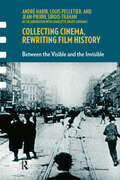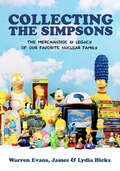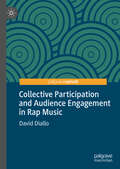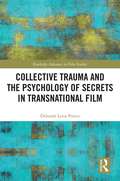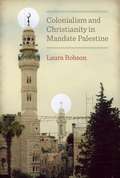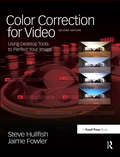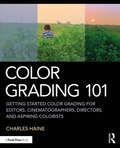- Table View
- List View
Cold War Cosmopolitanism: Period Style in 1950s Korean Cinema
by Christina KleinSouth Korea in the 1950s was home to a burgeoning film culture, one of the many "Golden Age cinemas" that flourished in Asia during the postwar years. Cold War Cosmopolitanism offers a transnational cultural history of South Korean film style in this period, focusing on the works of Han Hyung-mo, director of the era’s most glamorous and popular women’s pictures, including the blockbuster Madame Freedom (1956). Christina Klein provides a unique approach to the study of film style, illuminating how Han’s films took shape within a "free world" network of aesthetic and material ties created by the legacies of Japanese colonialism, the construction of US military bases, the waging of the cultural Cold War by the CIA, the forging of regional political alliances, and the import of popular cultures from around the world. Klein combines nuanced readings of Han’s sophisticated style with careful attention to key issues of modernity—such as feminism, cosmopolitanism, and consumerism—in the first monograph devoted to this major Korean director. A free open access ebook is available upon publication. Learn more at www.luminosoa.org.
Cold War II: Hollywood's Renewed Obsession with Russia
by Tatiana Prorokova-KonradContributions by Thomas J. Cobb, Donna A. Gessell, Helena Goscilo, Cyndy Hendershot, Christian Jimenez, David LaRocca, Lori Maguire, Tatiana Prorokova-Konrad, Ian Scott, Vesta Silva, Lucian Tion, Dan Ward, and Jon Wiebel In recent years, Hollywood cinema has forwarded a growing number of images of the Cold War and entertained a return to memories of conflicts between the USSR and the US, Russians and Americans, and communism and capitalism. Cold War II: Hollywood’s Renewed Obsession with Russia explores the reasons for this sudden reestablished interest in the Cold War. Essayists examine such films as Guy Ritchie’s The Man from U.N.C.L.E., Steven Spielberg’s Bridge of Spies, Ethan Coen and Joel Coen’s Hail, Caesar!, David Leitch’s Atomic Blonde, Guillermo del Toro’s The Shape of Water, Ryan Coogler’s Black Panther, and Francis Lawrence’s Red Sparrow, among others, as well as such television shows as Comrade Detective and The Americans. Contributors to this collection interrogate the revival of the Cold War movie genre from multiple angles and examine the issues of patriotism, national identity, otherness, gender, and corruption. They consider cinematic aesthetics and the ethics of these representations. They reveal how Cold War imagery shapes audiences’ understanding of the period in general and of the relationship between the US and Russia in particular. The authors complicate traditional definitions of the Cold War film and invite readers to discover a new phase in the Cold War movie genre: Cold War II.
Cold War Rivalry and the Perception of the American West
by Pawel GoralThis book demonstrates how the two adversaries of the Cold War, West Germany and East Germany, endeavored to create two distinct and unique German identities. In their endeavor to claim legitimacy, the German cinematic representation of the American West became an important cultural weapon of mass dissemination during the Cold War.
Cold War Spy Stories from Eastern Europe
by Valentina Glajar Alison Lewis Corina L. PetrescuDuring the Cold War, stories of espionage became popular on both sides of the Iron Curtain, capturing the imagination of readers and filmgoers alike as secret police quietly engaged in surveillance under the shroud of impenetrable secrecy. And curiously, in the post–Cold War period there are no signs of this enthusiasm diminishing. The opening of secret police archives in many Eastern European countries has provided the opportunity to excavate and narrate for the first time forgotten spy stories. Cold War Spy Stories from Eastern Europe brings together a wide range of accounts compiled from the East German Stasi, the Romanian Securitate, and the Ukrainian KGB files. The stories are a complex amalgam of fact and fiction, history and imagination, past and present. These stories of collusion and complicity, betrayal and treason, right and wrong, and good and evil cast surprising new light on the question of Cold War certainties and divides.
Cold War Theatre (Routledge Revivals)
by John ElsomCold War Theatre, first published in 1992, provides an account of the theatrical history within the context of East/West politics. Its geographical span ranges from beyond the Urals to the Pacific Coast of the US, and asks whether the Cold War confrontation was not in part due to the cultural climate of Europe. Taking the McCarthy era as its starting point, this readable history considers the impact of the Cold War upon the major dramatic movements of our time, East and West. The author poses the question as to whether European habits of mind, fostered by their cultures, may not have contributed to the political stalemates of the Cold War. A wide range of actors from both the theatrical and political stages are discussed, and their contributions to the theatre of the Cold War examined in a hugely enjoyable and enlightening narrative. This book is ideal for theatre studies students.
Cole Porter: The Definitive Biography
by William McbrienIn his life and in his music, Cole Porter was "the top"--the pinnacle of wit, sophistication, and success. His songs--"I Get a Kick Out of You," "Anything Goes," and hundreds more--were instant pop hits, and their musical and emotional depths have made them lasting standards.William McBrien has captured the creator of these songs, whose life was not merely one of wealth and privilege. A prodigal young man, Porter found his emotional anchor in a long, loving, if sexless marriage, a relationship he repeatedly risked with a string of affairs with men. His last eighteen years were marked by physical agony but also unstinting artistic achievement, including the great Hollywood musicals High Society, Silk Stockings, and Kiss Me Kate (recently and very successfully revived on Broadway). Here, at last is a life that informs the great music and lyrics through illuminating glimpses of the hidden, complicated, private man.
Cole and Sav: Our Surprising Love Story
by Savannah LaBrant Cole LabrantPopular YouTubers the Labrant Fam share their inspiring love story of how Savannah, a young, single mom, fell in love with Cole, a 19-year-old from Alabama, highlighting the redemptive, surprising nature of God at work in our lives.The Labrant Fam—Cole, Savannah, and their daughter, Everleigh—have laughed, pranked, and danced their way into the hearts of millions of viewers. But by all accounts, Cole and Savannah shouldn&’t have met each other—let alone fallen in love.Sav was a 23-year-old from Southern California who had grown up with the pain of her parents&’ broken marriage. As a single mother with a history of unhealthy relationships, she had all but given up on a happily ever after.Cole was a 19-year-old from a small town in Alabama who had never dated seriously but held high hopes for marriage. Cole was slowly learning how to trust life's twists and turns. Then, through a surprise encounter, their lives changed forever.In this heartwarming memoir, you&’ll discover:The heartbreak Savannah faced as a young, single mom before she met ColeTheir individual stories growing upSavannah&’s pregnancy at 19 and how she found fame on social mediaHow they met and fell in loveWith their signature charming and engaging style, Cole and Sav take you behind the camera and open up about past heartaches and mistakes; painful secrets and difficult expectations; the joys and challenges of raising their daughter, Everleigh; and the spiritual journey that changed their hearts—and relationship—forever.
Colin Thackery – My Story: How Love Changed Everything – from the Winner of Britain's Got Talent
by Colin ThackeryA tale of survival, love, hardship, family, heartbreak and triumph.This is the incredible story of 89-year-old Chelsea Pensioner Sergeant Major Colin Thackery who, in 2019, made history by becoming the oldest person to win Britain's Got Talent. The show gave a glimpse into Colin's history, but the truth of his unique and eventful life is far more gripping and surprising than viewers could have imagined. Enthralling, poignant and inspiring, this book tells Colin's story, from being a child helping Air Raid Wardens during The Blitz, through fighting in the Korean War, touring the world with the army, becoming a widower after 66 years of marriage, life as a Chelsea Pensioner and touching the nation's hearts with his show-winning singing in honour of his late wife, Joan.Ultimately, Colin's story is a tale of triumph: of resilience in the hardest of times; of hope in the face of despair; and of everlasting love.
Colin Thackery – My Story: How Love Changed Everything – from the Winner of Britain's Got Talent
by Colin ThackeryA tale of survival, love, hardship, family, heartbreak and triumph.This is the incredible story of 89-year-old Chelsea Pensioner Sergeant Major Colin Thackery who, in 2019, made history by becoming the oldest person to win Britain's Got Talent. The show gave a glimpse into Colin's history, but the truth of his unique and eventful life is far more gripping and surprising than viewers could have imagined. Enthralling, poignant and inspiring, this book tells Colin's story, from being a child helping Air Raid Wardens during The Blitz, through fighting in the Korean War, touring the world with the army, becoming a widower after 66 years of marriage, life as a Chelsea Pensioner and touching the nation's hearts with his show-winning singing in honour of his late wife, Joan.Ultimately, Colin's story is a tale of triumph: of resilience in the hardest of times; of hope in the face of despair; and of everlasting love.
Colin Thackery – My Story: How Love Changed Everything – from the Winner of Britain's Got Talent
by Colin ThackeryA tale of survival, love, hardship, family, heartbreak and triumph.This is the incredible story of 89-year-old Chelsea Pensioner Sergeant Major Colin Thackery who, in 2019, made history by becoming the oldest person to win Britain's Got Talent. The show gave a glimpse into Colin's history, but the truth of his unique and eventful life is far more gripping and surprising than viewers could have imagined. Enthralling, poignant and inspiring, this book tells Colin's story, from being a child helping Air Raid Wardens during The Blitz, through fighting in the Korean War, touring the world with the army, becoming a widower after 66 years of marriage, life as a Chelsea Pensioner and touching the nation's hearts with his show-winning singing in honour of his late wife, Joan.Ultimately, Colin's story is a tale of triumph: of resilience in the hardest of times; of hope in the face of despair; and of everlasting love.(p) Octopus Publishing Group
Collaboration in Performance Practice: Premise, Workings and Failures
by Noyale Colin Stefanie SachsenmaierCollaboration between artists has been practised for centuries, yet over recent decades the act of collaborating has taken different meanings. This publication examines cultural, philosophical and political issues tied to specific instances of collaborative practice in the performing arts. Leading scholars and practitioners review historical developments of collaborative practice and reveal what it means to work together in creative contexts at the beginning of the twenty-first century. Key questions addressed include how artists are developing new ways of working together in response to contemporary economic trends, the significance of collaborating across culture and what opportunities are apparent when co-working between genres and disciplines. Noyale Colin and Stefanie Sachsenmaier present these perspectives in three thematic sections which interrogate the premises of collective intentions, the working strategies of current practitioners, as well as the role of failure and compromise in collaborative modes of creative work. This volume is an invaluable resource for scholars, practitioners and those interested in contemporary artistic methods of working.
Collaborative Intimacies in Music and Dance: Anthropologies of Sound and Movement (Dance and Performance Studies #10)
by Evangelos Chrysagis Panas KarampampasAcross spatial, bodily, and ethical domains, music and dance both emerge from and give rise to intimate collaboration. This theoretically rich collection takes an ethnographic approach to understanding the collective dimension of sound and movement in everyday life, drawing on genres and practices in contexts as diverse as Japanese shakuhachi playing, Peruvian huayno, and the Greek goth scene. Highlighting the sheer physicality of the ethnographic encounter, as well as the forms of sociality that gradually emerge between self and other, each contribution demonstrates how dance and music open up pathways and give shape to life trajectories that are neither predetermined nor teleological, but generative.
Collaborative Performance for Social Justice: In Classrooms, on Campuses, and with Communities (Routledge Social Justice Communication Activism Series)
by Tessa Carr Deanna ShoemakerThis engaging book offers a broad spectrum of collaborative and accessible performance-based practices that promote social justice within college classrooms, rehearsal spaces, campus stages and local communities.Performance is an inherently collective and embodied endeavor. As a form of communication activism, performance also serves as a powerful mode of teaching and learning that demands equitable relationships and mutually established group norms that offer all a seat at the table. Informed by intersectional feminist and antiracist theories, the authors present collaborative performance case studies, ranging from interventions into local histories of oppression to creative protests of campus and cultural practices, to staged interruptions of social discourses and representational systems that perpetuate structural inequities. Illustrating the multiple possibilities of performance, the book offers adaptable tools, evocative stories, and vivid examples from diverse bodies of work. This engaged scholarship is committed to honoring multiple forms of knowledge, acknowledging and building the capacities of individuals and organizations, identifying and developing more spaces for critical dialogue, and envisioning and performing a more socially just world.This book is essential reading for scholars and practitioners of communication, theater, performance studies, arts-based education, and social justice activism.
Collaborative Screenwriting and Story Development: A Global Guide for Writers, Story Teams, and Creative Executives
by Marc HandlerThis is a comprehensive guide to teach writing and story development from a collaborative global perspective. This book teaches writers how to take full advantage of emerging opportunities, both locally and globally. With an increasing number of international co-productions and many screenwriters now working collaboratively in writers rooms and development groups, author Marc Handler explains how to work cooperatively with others to break stories, plan seasons, create characters, and build series. To succeed, readers will learn how to give and receive feedback effectively, adapt to the style and constraints of executives and brands, and contribute to the team building process, all within an increasingly global media industry that is in constant flux. This book will help readers develop a global perspective, ensuring that they are prepared for new opportunities as they arise. Marc Handler provides cultural insight and understanding as he describes the fundamentals as well as advanced story skills. This book is essential reading for students taking classes such as Screenwriting Fundamentals, Writing for Film and TV, Introduction to Television Writing, and Advanced Screenwriting, as well as aspiring and early career screenwriters, showrunners, producers, and creative executives.
Collaborative Theatre: Le Theatre du Soleil
by David Williams Eric PrenowitzOver the past thirty years Ariane Mnouchkine's 'Théâtre du Soleil' has become one of the most celebrated companies in Europe, and Mnouchkine one of its best-known directors. Collaborative Theatre is the first in-depth sourcebook in English on 'Théâtre du Soleil', providing English readers with first-hand accounts of the development of its collectivist practices and ideals.Collaborative Theatre presents critical and historical essays by theatre scholars from around the world as well as the writings of and interviews with members of le Théâtre du Soleil, past and present. Projects discussed include: 1789, L'Age d'Or, Richard II, L'Indiade and Les Atriades.
Collected Essays (Penguin Classics)
by Arthur Miller Susan C. AbbotsonThe collected essays of the "moral voice of [the] American stage" (The New York Times) in a Penguin Classics Deluxe Edition Arthur Miller was not only one of America's most important twentieth-century playwrights, but he was also one of its most influential literary, cultural, and intellectual voices. Throughout his career, he consistently remained one of the country's leading public intellectuals, advocating tirelessly for social justice, global democracy, and the arts. Theater scholar Susan C. W. Abbotson introduces this volume as a selection of Miller's finest essays, organized in three thematic parts: essays on the theater, essays on specific plays like Death of a Salesman and The Crucible, and sociopolitical essays on topics spanning from the Depression to the twenty-first century. Written with playful wit, clear-eyed intellect, and above all, human dignity, these essays offer unmatched insight into the work of Arthur Miller and the turbulent times through which he guided his country. For more than seventy years, Penguin has been the leading publisher of classic literature in the English-speaking world. With more than 1,700 titles, Penguin Classics represents a global bookshelf of the best works throughout history and across genres and disciplines. Readers trust the series to provide authoritative texts enhanced by introductions and notes by distinguished scholars and contemporary authors, as well as up-to-date translations by award-winning translators.From the Trade Paperback edition.
Collecting Cinema, Rewriting Film History: Between the Visible and the Invisible (Framing Film)
by Louis Pelletier André Habib Jean-Pierre Sirois-Trahan Charlotte Brady-SavignacThe writing of cinema history would not be possible without the contribution of collectors. Whether through their pioneering excavation work or their passionate defence of forgotten productions and artifacts, collectors have had a lasting influence on both the field and the methods of moving image history. Proceeding from a renewed dialogue between international film scholars, collectors, filmmakers, curators, and archivists, this book aims to reveal the extent to which collectors and collections have contributed to both the history and the epistemology of moving images. It showcases specific studies of collecting practices, as well as in-depth interviews with collectors and artists bringing to light the innumerable articulations between collecting cinema and the rewriting of film history.
Collecting The Simpsons: The Merchandise & Legacy of Our Favorite Nuclear Family
by James Hicks Warren Evnas Lydia HicksThe Simpsons Merchandise Guide for all Simpsons Lovers “What are the two things every Simpsons’ collector needs? This book and shelves! “ ─Stephanie Gillis, Writer on The Simpsons#1 Best Seller in TV History & CriticismThis quirky book unleashes the entire story of all Simpsons merchandise, spanning decades. Lydia and James Hicks, authors of the bestselling The Simpsons Secret, partner with Warren Evans, the Bart of Darkness, to detail a massive collection of rare Simpsons memorabilia.Jump right into 90s nostalgia! Simpsons lovers everywhere, explore the explosion of Simpsons merchandise and products right in the comfort of your own home. From action figures, video games, comics, lunch boxes, and yes, even cookie jars, this book is a collector's paradise full of insightful information.The perfect collector’s item to have! This full-color guide features high quality photos of Simpsons-inspired products and is the perfect gift for Simpsons lovers as well as fans of Friends, Family Guy, and other classics!Inside:Read for fun: all of the words of Warren Evans, a note-worthy expert on The Simpsons familyFind full-colored photographs of Simpsons merchandise and collector items from the beginning of The Simpsons dynastyIf you're looking for one of the best books for TV nerds who like The Big Bang Theory, Welcome to Dunder Mifflin, or The Simpsons Secret, then Collecting the Simpsons belongs right on your bookshelf!
Collective Participation and Audience Engagement in Rap Music (Pop Music, Culture and Identity)
by David DialloWhy do rap MCs present their studio recorded lyrics as “live and direct”? Why do they so insistently define abilities or actions, theirs or someone else’s, against a pre-existing signifier? This book examines the compositional practice of rap lyricists and offers compelling answers to these questions. Through a 40 year-span analysis of the music, it argues that whether through the privileging of chanted call-and-response phrases or through rhetorical strategies meant to assist in getting one’s listening audience open, the focus of the first rap MCs on community building and successful performer-audience cooperation has remained prevalent on rap records with lyrics and production techniques encouraging the listener to become physically and emotionally involved in recorded performances. Relating rap’s rhetorical strategy of posing inferences through intertextuality to early call-and-response routines and crowd-controlling techniques, this study emphasizes how the dynamic and collective elements from the stage performances and battles of the formative years of rap have remained relevant in the creative process behind this music. It contends that the customary use of identifiable references and similes by rap lyricists works as a fluid interchange designed to keep the listener involved in the performance. Like call-and-response in live performances, it involves a dynamic form of communication and places MCs in a position where they activate the shared knowledge of their audience, making sure that they “know what they mean,” thus transforming their mediated lyrics into a collective and engaging performance.
Collective Trauma and the Psychology of Secrets in Transnational Film (Routledge Advances in Film Studies)
by Deborah Lynn PorterCollective Trauma and the Psychology of Secrets in Transnational Film advances a methodological line of inquiry based on a fresh insight into the ways in which cinematic meaning is generated and can be ascertained. Premised on a critical reading strategy informed by a metapsychology of secrets, the book features analyses of internationally acclaimed films—Guillermo del Torro’s Pan’s Labyrinth, Andrey Zvyagintsev’s The Return, Jee-woon Kim’s A Tale of Two Sisters, and Alejandro Amenábar’s The Others. It demonstrates how a rethinking of the figure of the secret in national film yields a new vantage point for examining heretofore unrecognized connections between collective historical experience, cinematic production and a transnational aesthetic of concealment and hiding.
Colonialism and Christianity in Mandate Palestine
by Laura RobsonDrawing on a rich base of British archival materials, Arabic periodicals, and secondary sources, Colonialism and Christianity in Mandate Palestine brings to light the ways in which the British colonial state in Palestine exacerbated sectarianism. By transforming Muslim, Christian, and Jewish religious identities into legal categories, Laura Robson argues, the British ultimately marginalized Christian communities in Palestine. Robson explores the turning points that developed as a result of such policies, many of which led to permanent changes in the region's political landscapes. Cases include the British refusal to support Arab Christian leadership within Greek-controlled Orthodox churches, attempts to avert involvement from French or Vatican-related groups by sidelining Latin and Eastern Rite Catholics, and interfering with Arab Christians' efforts to cooperate with Muslims in objecting to Zionist expansion. Challenging the widespread but mistaken notion that violent sectarianism was endemic to Palestine, Colonialism and Christianity in Mandate Palestine shows that it was intentionally stoked in the wake of British rule beginning in 1917, with catastrophic effects well into the twenty-first century.
Color Correction for Video: Using Desktop Tools to Perfect Your Image (Dv Expert Ser.)
by Steve Hullfish Jaime FowlerUse color to improve your storytelling, deliver critical emotional cues, and add impact to you videos. This book shows you how to analyze color correction problems and solve them- whatever NLE or plugin you use. Experienced editors and colorists in their own right, the authors also include the wisdom of top colorists, directors of photography, and color scientists to deliver this insightful and authoritative presentation of the theory and practice of color correction.The book provides technical insight into how to effectively color correct your video, also delving into how color can impact storytelling and deliver critical emotional cues. The new edition also includes 2 new "Quickstart Tutorials", a new chapter on how color impacts storytelling, information on the impact HD has had on the correcting process, and updated application specifications. The companion DVD features new and more robust tutorial media.
Color Dance
by Ann JonasA girl in red, a girl in yellow, a girl in blue, and a boy in black and white are all set to stir up the rainbow. Watch them create a living kaleidoscope, step by step by step.
Color Grading 101: Getting Started Color Grading for Editors, Cinematographers, Directors, and Aspiring Colorists
by Charles HaineWritten both for students and working professionals, this book walks readers step-by-step through the foundations of color grading for projects of any size, from music videos and commercials to full-length features. In this clear, practical, and software-agnostic guide, author Charles Haine introduces readers to the technical and artistic side of color grading and color correction. Color Grading 101 balances technical chapters like color-matching, mastering, and compression with artistic chapters like contrast/affinity, aesthetic trends, and building a color plan. The book also includes more business-focused chapters detailing best practices and expert advice on working with clients, managing a team, working with VFX, and building a business. An accompanying eResource offers downloadable footage and project files to help readers work through the exercises and examples in the book. This book serves as a perfect introduction for aspiring colorists as well as editors, cinematographers, and directors looking to familiarize themselves with the color grading process.
